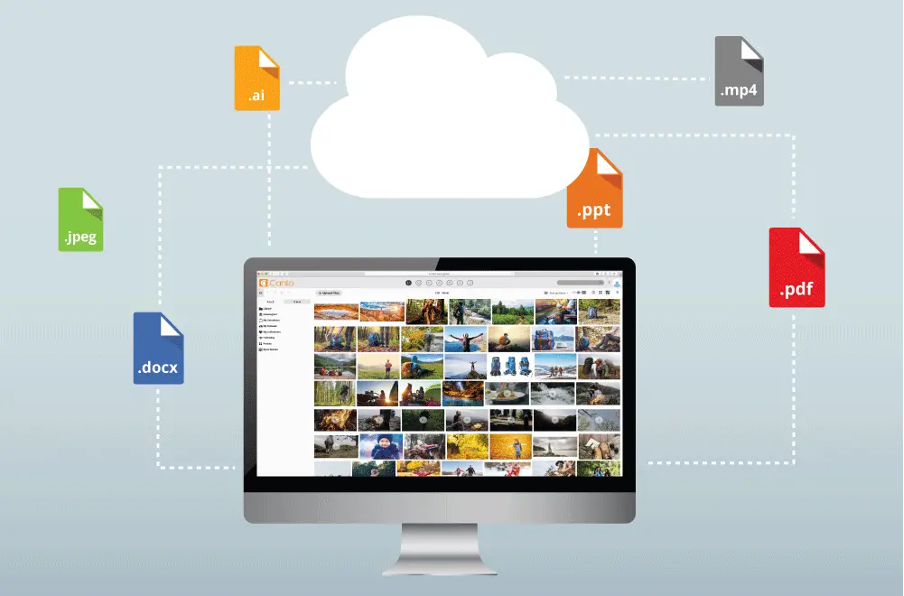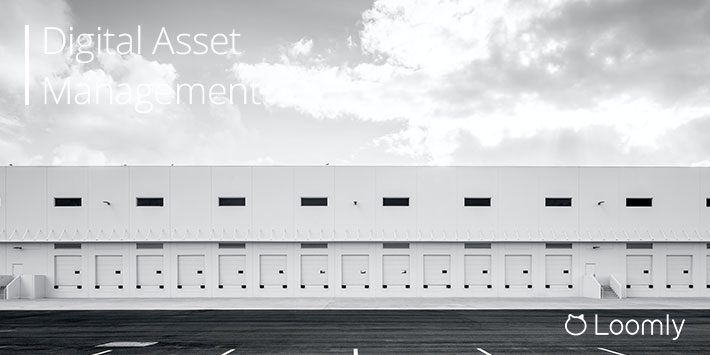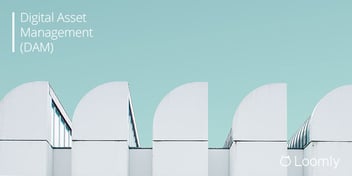Digital Asset Management FAQ
Is there anything more frustrating (in professional life at least) than trying to find misplaced files?
- 84% of businesses report that finding digital assets is the biggest challenge they have when working with content.
- The average person looks for a media file 83 times a week and fails to find it 35% of the time.
But it doesn’t have to be this way.
Digital asset management (DAM) can save you countless hours and improve your productivity.
In this Digital Asset Management FAQ, the Loomly Team answers all your DAM questions.
TABLE OF CONTENTS
- What are digital assets?
- What is digital asset management?
- How does digital asset management work?
- How should you manage digital assets in your company?
- Why is digital asset management important?
- What is the role of a digital asset manager?
- What is a digital asset management system?
- What are the best digital asset management tools?
- How much does a digital asset management system cost?
- How do you measure the ROI of digital asset management?
What are digital assets?
Digital assets are electronic files that are stored on a digital storage drive or computer system. Items crafted by hand can also become a digital asset. For example, a painting or handwritten note become digital assets when they are scanned and uploaded to a computer.
In short: a digital asset is content that’s stored digitally.
Unlike the days of paper document filing, there are many types of digital asset that need to be managed and stored.

Credit: OpenAsset
Examples of digital assets include:
- Photos
- Videos
- Design files
- Word documents
- PDFs
- Company branding
- Presentations
- Marketing content and collateral
Digital assets aren’t restricted to these file formats – they include data packages, user data, user accounts, cryptocurrency tokens, and many other sensitive or high-value files.
Since the business world is becoming progressively digitized, the amount of digital content that needs to be managed is rising rapidly. Because of the increase in volume, employees will require instant and easy access to the assets they need to do their jobs.
What is digital asset management?
Digital asset management (DAM) is a system that stores, shares, and organizes digital assets in a central location so that teams can easily access content, such as:
- Images
- Videos
- Audio files
- Documents

Credit: Canto
Ultimately, a digital asset management system is a company’s content sharing and storage solution that benefits both single and cross-functional teams as it can:
- Reduce bottlenecks
- Save time
- Speed up workflows
How does digital asset management work?
Let’s say you are part of a marketing team and want to streamline your social media management processes.
You can create a seamless social media workflow by using a digital asset management tool to store all of the files you need to publish your updates.
The tool can be accessed by everyone in your marketing team, including:
- Photographers
- Graphic designers
- Videographers
- Content creators
They can then upload all of their files to a central location where you and team members can easily find them.
However, the benefits of DAM go far beyond social media management.
Any brand which uses the internet as part of their business has digital assets that need to be effectively stored and managed.
- Websites
- Sales pages
- Content marketing
- Direct marketing
- Social media marketing
- Digital products
- Written documents
- Audio files
- Video files
- File sharing between departments
If you rely on any of these to make your business work, then having software to help you effectively manage your digital assets can only improve your business processes.
How should you manage digital assets in your company?
Here are five tips for managing digital assets in your company:
- Start with your most popular assets – it makes sense to identify your most popular assets first, especially if you share brand assets across teams within an enterprise or with partners through branded portals. These will prove the ROI of your media library.
- Sort assets into an organizing structure – adopt whatever folder categorization schema makes sense for your organization, such as product name, product style, or product manufacturer, and so on.
- Label your assets with metadata – the most important thing you can do regarding asset organization is to tag each file with appropriate metadata, such as titles, image tags, date created, and author name.
- Keep versions and alternates – creatives keep past versions of files, as well as alternate files, that go into a finished asset.
- Don’t forget about formats – store a range of predefined image file formats (png, jpg, etc.), image sizes (social media), and resolutions (high and low) so that everyone can benefit from a “one-stop-shop” for their end-use needs.
Bottom line: your content marketing strategy is only as effective as your means to organize your digital assets.
Why is digital asset management important?
Three core benefits of digital asset management are:
- Increases efficiency: In marketing, graphic designs and imagery are constantly used to boost content by adding visual appeal. DAM helps boost productivity and efficiency by eliminating the need to request assets every time they’re used. By housing all illustrations and images in one location, the design team can devote their time to creating assets rather than searching for them. This reduces design requests and prevents any rework on assets that have already been completed.
- Maintains brand integrity and consistency: Logos, color palettes, photos, and videos are frequently used across marketing materials. Too often, old logos and outdated images are used because people couldn’t find or weren’t aware of the latest versions. Having a centralized repository for all digital assets ensures teams, partners, affiliates, agencies, and clients always have access to the latest approved versions of files.
- Provides secure asset allocation: When images and files are floating around in emails and documents, it’s impossible to know who can access them. DAM helps centralize and manage control over digital assets by setting up permissions and different access levels to files. This security allows your design team to control who has access to files, and to provide guidelines on where and how to use them.
What is the role of a digital asset manager?
A digital asset manager is responsible for curating, organizing, documenting, cataloging, and managing all digital assets, including images, videos, written content, audio, testimonials, reviews, and more.
A digital asset manager is also responsible for how employees and external stakeholders can access, use, and interact with these assets. It’s a highly collaborative job that can encompass responsibilities such as the proper management of usage rights and file permissions.
What is a digital asset management system?
A digital asset management system is a secure repository that facilitates the creation, management, organization, production, distribution, and, potentially, monetization of media files identified as digital assets.
A DAM system, similar to other content management technologies, provides essential library services: a centralized common repository for storing, arranging, and retrieving documents.
It also provides core process services, including specific facilities for the management, manipulation, transformation, security, movement, and processing of rich media files and their metadata.
The majority of DAM systems now integrate with other tools and systems, which can be particularly useful to a content marketer. You won’t need to worry about whether you’re accessing the most recent version of a logo or piece of content.
What are the best digital asset management tools?
The best digital asset management tools are:
- Widen
- Brandfolder
- Bynder
- PhotoShelter for Brands
- Canto
- Image Relay
- monday.com
- Mediafly
- IntelligenceBank
- Syndigo Content Experience Hub
How much does a digital asset management system cost?
Digital asset management systems vary in price according to their size and functionality:
- Small systems start from around $25 per month for a single user with limited storage and options.
- Mid-range systems support multiple users and include 50-300GB of storage, ranging from $2,300 – $15,000 per annum. These systems typically have a lot of additional options which can take the price into the enterprise bracket.
- High-end systems are fully customizable for enterprise use with unlimited users and storage, ranging from $15,000 – $250,000.

Credit: Thirdlight
How do you measure the ROI of digital asset management?
As with all things, measuring the ROI of digital asset management depends on several factors that impact the costs:
- The makeup of your team.
- The quality of your internal processes.
- The quality of communication within your organization.
Even for small teams, the potential savings from digital asset management are projected to be tens of thousands of dollars a year. And can quickly grow into hundreds and hundreds of thousands of dollars per year for large teams or companies using outdated processes.
Digital asset management systems can cost as little as about $1000 per year for a small team to as much as $10,000+ per month for a sophisticated enterprise solution.
ROI is calculated like this:
ROI = (Gain from investment – Cost of investment)/(Cost of investment)
*Expressed as a %.
For example:
A small team of six marketers using Image Relay’s Professional plan and considering only their search and fulfillment costs.
Gain from investment = $68,400 saved in search costs + $20,000 saved in fulfillment costs = $88,400
Cost of investment = $9,000 ($750 per month)
ROI = ($88,400 – $9,000)/$9,000 = 882.22%

Manage all your social media accounts in one place.
Craft, schedule, & auto-post content to all your social channels, then track analytics and manage interactions from a single, easy-to-use dashboard.
Digital Asset Management FAQ in a Nutshell
A digital asset management system can save you and your organization countless hours searching for elusive assets.
It makes it easy for everyone in your organization to upload, store, and manage all of your assets in one central, secure location. Even better, it can improve your workflows, increase productivity, and save you time and money over the long term.



